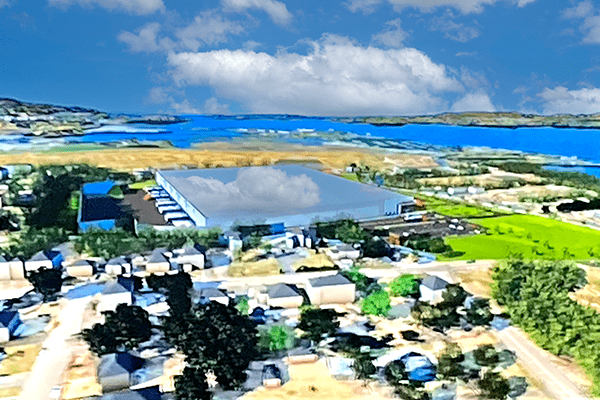|
RCBJ-Audible (Listen For Free)
|
Former Construction & Demolition Debris Dumping Ground Off-Gassing Methane: Developer Working On Getting DEC Approvals To Move Forward on Cleanup and Capping
By Tina Traster
What is not in dispute is that the Village of West Haverstraw has a methane off-gassing, 34-acre, uncapped construction and demolition debris landfill sitting along Ecology Lane and Beach Road, that was never properly closed. Instead, the grassy hill is covered with two feet of topsoil and overgrown vegetation, and slated to become the site of a massive 24/7 warehouse, if the developer’s application is approved.
“This is a beneficial re-use,” said Pomante. “It’s more viable than a vacant piece of land.”
The question put to the Village’s land use boards last week is whether a developer’s plan to properly close and cap the landfill and build a 454,000 square-foot 76-bay warehouse is a better solution than leaving the site fallow. The Village’s Planning Board and Zoning Board of Appeals met simultaneously last Wednesday to hear the application.
“This has been before the board since 2022,” said Terresa Bakner, the attorney from Whiteman Osterman & Hanna LLP of Albany, who is representing landowner Eric Berstol. “We have been providing information to the board, the Village, Rockland County, the New York Department of Environmental Conservation and other agencies.”
Berstol is collaborating with New Jersey developer Efrem Gerszberg to build the proposed $60 million to $80 million warehouse that will require an extensive environmental cleanup and continuous monitoring system.
The proposed distribution center sits in a Planned Light Industrial district on the edge of the Village. The high-stakes project raises several concerns including noise, truck traffic on narrow flood-prone roads, the proximity to the train crossing on Route 9W, and the fact that the applicant says it does not have a specific tenant. Also, the project will be sited less than 160 feet from the entry to the proposed county animal shelter Rockland Green hopes to build on Ecology Lane in a vacant warehouse.
What looms large for now are the environmental challenges of cleaning up and capping the landfill, which is filled with construction and demolition debris and off-gassing methane – just like the Haverstraw Town-owned landfill just on the other side of Ecology Lane. The proposed animal shelter sits between two landfills that, according to the developer’s expert at Boswell Engineering of Hackensack, New Jersey, leach heavy metals in the water table beneath the warehouse that Rockland Green plans to transform into a $20 million animal shelter.
The proposed vegetative parcel is demarcated by a residential neighborhood to the west, a flood-prone road to the south (Beach Road/Railroad Avenue), and the skinny Ecology Lane to the north, which will serve as the egress and ingress for trucks coming and going from the warehouse 24/7.
To the east of the property is the Minisceongo Creek, which frequently floods the area and raises issues over runoff.
The Rockland County Drainage Agency has raised a raft of issues the developer will have to address because of the proximity of the planned development and potential runoff into the creek.
The Rockland County Drainage Agency (RCDA) is concerned about what it said was incomplete information that was inhibiting its review of the Stormwater Management Report. It sought to confirm that the proposed development will result in no increase in the rate of stormwater runoff from the site for 100-year storm events and indicated that errors in calculations would require additional and corrected submissions from the developer.
The developer is relying on stormwater management that includes retention ponds and a system of swales to slowly move water off site and into the Minisceongo Creek, a water body already prone to flooding.
The application appears to be gaining momentum while the developer endeavors to iron out the environmental hurdles with the NYS DEC over how to cap the construction landfill. For the project to proceed, the agency must be satisfied the landfill can be safely capped and that controls are in place to monitor the site going forward. The applicant acknowledges that a portion of the site contains heavy metals and that the landfill extends beyond the boundaries of the proposed site.
The site, once owned by North Rockland Associates since 1969, was an active construction and demolition debris landfill through the mid-1990s. Before that the site was a clay pit quarry used when Haverstraw was a brick-making center. When the clay pit was exhausted, it became a dumping ground for construction material. In 2019, the North Rockland Associates site was transferred to a new entity, Grassy Point Bend LLC, owned by Bergstol.
The North Rockland Associates site, as it was known, is listed on the NYSDEC’s Solid Waste Site Mitigation and Remediation Priority List.
It remains unclear why the DEC never took steps to ensure that the landfill was properly closed, or why the former owner abandoned its obligations to close and maintain the site in accordance with New York State law.
The DEC noted in a letter dated May 30, 2024 that the former Construction and Demolition Debris landfill was never properly “closed” after it ceased accepting debris in the 1993, and that re-use of the property required proper closure as part of the developer’s application.
The DEC is concerned the site was not properly covered and that no gas management system has been in place for decades. The original two-foot soil cover was non-compliant for closure as there was no low permeability soil layer beneath it or other required components that would have been required for a landfill that operated past 1988. The applicant is requesting that it be allowed to mow down the vegetation to its roots to prevent further downward growth and penetration into the soil layer. That issue remains unresolved.
The DEC has also cited concern that the “end-use” plan did not include measures to address liquid, hazardous, industrial, medical, or explosive waste, if any were found when the site was re-graded. And, that no plan was provided, should there be a need to remove soil from the site.
The DEC also expressed discomfort with the proposed asphalt cap – rather, it requires an impermeable layer below the surface soil, as well as monitoring in perpetuity for leachate and landfill gases.
The developer’s experts indicated they were having follow-up meetings with both the DEC and the RCDA to answer questions and address those concerns.
Frank Rossi, of Boswell Engineering of Hackensack New Jersey, went over the DEC’s response to the applicant, count by count. With each concern, he used the refrain “that’s not a problem.” Though he acknowledged the DEC has been less than communicative lately, he told both land-use boards that there were no issues cleaning up the landfill that were insurmountable.
In particular, he showed the board a sample of a foamy barrier made of cells that “acts as a way of ventilating up through the piers.” This method, he said, will prevent the build-up of gas inside the building if and when the site is covered with a 454,000 square-foot warehouse. He also outlined plans to use water to control dust, and to reroute leachate to the Joint Sewer Treatment Plant, which also sits along Ecology Lane.
Rossi pointed out the project, due to the extensive cleanup, is estimated to cost between $60 million to $80 million, calling it a “heavy lift.” He told the boards his clients want to keep the application moving forward, and paused to ask, “Are you guys going to fight us to the death? We need cooperation.”
No board member outwardly expressed opposition to the project.
Rossi, along with Joseph A. Pomante, an engineer with Boswell Engineering, both couched the project as the better of two choices: move forward with a cleanup and build a warehouse or leave the methane off-gassing landfill without a plan.
“This is a beneficial re-use,” said Pomante. “It’s more viable than a vacant piece of land.”
Even if the applicant gets DEC and RCDA approval, and the project moves forward because it’s in an as-of-right zone for a warehouse, it will also need variances from the Village Zoning Board of Appeals for height (code allows for 35 feet; developer is seeking 43 feet) and parking (code requires 908 spaces based on the building size, developer says only 369 spaces are required for its use).
Pomante, in a simulated presentation, showed the boards a system of sound barriers that would ring the project on three sides to protect residential neighborhoods. The engineer said that would keep night-time noise to 36 decibels – the equivalent of ambient nighttime noise. There is no sound barrier planned along the northern edge along Ecology Lane, where the potential new county animal shelter will sit roughly 160 feet from the proposed warehouse.
“We have mitigated noise with sound walls between the parking lot and the surrounding neighborhood,” said Pomante. Plans for the $20 million and rising Rockland Green animal shelter do not include soundproofing. Rockland Green Chair Howard Phillips has said that the elimination of soundproofing at the shelter will save taxpayers money.
At least three land use board members raised concerns over truck traffic, expressing particular concern over the narrow Beach Road, where passing cars now come razor close, as well as Ecology Lane, which will serve 24/7 as both an egress and ingress for the warehouse – as well the narrow barrier between truck traffic and an animal shelter where people and employees come and go.
Though pushed for more information on who the end user would be, Pomante only said “it won’t be an Amazon drop station.” Board members also tried to pin down whether 76 bays would be used simultaneously but there was no way to determine this. Pomante also said the warehouse will be “Class A,” but when asked what they meant, he was unable to provide a definition, saying he was not an architect.










